Top 10 Software Testing Tools For 2025
Learn with AI
With a good software testing tool, QA teams can optimize processes, achieve higher test coverage, and increase overall testing efficiency. They can choose a tool dedicated to a specific purpose or a comprehensive solution that supports multiple stages of the testing lifecycle.
In this article, we’ll guide you through selecting the type of testing tool that best fits your strategy.
Software Testing Tools Categorized By Scope
When it comes to testing, teams generally have three options:
- Open-source testing tools, libraries, or frameworks
- Single-point commercial automation tools
- Software quality management platforms
Let’s look at how each option differs.
1. Open-source software testing tools / libraries / frameworks
The first option is to adopt an open-source library and build a customized testing framework on top of it. These libraries provide the foundation for automation, but testers must build the framework themselves.
To build a strong automation framework, you need:
- Function libraries (e.g., Selenium, Playwright, Appium, Rest Assured)
- Browser drivers
- Knowledge of design patterns (Page Object Model, Screenplay, Fluent)
- Coding standards (KISS, DRY, camelCase)
- Test artifact management structures
- Reporting and execution logs
Testers must integrate these components into a functional framework—work that requires skill and time. The upside is complete customization and typically zero licensing cost. However, this approach also demands ongoing maintenance, as automation scripts often break when the application changes.
2. Single-point commercial automation testing tools
Here, instead of building everything internally, teams purchase a tool from a vendor. Maintenance, infrastructure, and updates are handled by the provider.
As the name suggests, these solutions are single-point—they focus on a specific area of the testing ecosystem. They can be categorized by:
- Application under test: web, mobile, desktop, etc.
- Application layer: UI, backend, API
- Attribute: functional, performance, visual, etc.
- Approach: manual, automated, AI-driven
- Granularity: unit testing, end-to-end testing
- Testing techniques: black-box, white-box, gray-box, based on how we execute tests
3. Software quality management platform
At this level, teams adopt an all-in-one solution that consolidates a wide range of testing capabilities into a single workspace.
These platforms offer keyword libraries for web, API, and mobile testing, built-in test authoring tools, traceability between requirements and tests, coverage analytics, and reusable automation components. There’s no need to integrate multiple single-point tools because everything is provided in one environment.
What is the trade-off between choosing an open-source and a commercial software testing solution?
Let’s meet Coty Rosenblath, a hands-on tech leader in enterprise software design, who shares his perspective:
Types of Software Testing Tools By Functionality

While the investment in automated software testing tools has proven clear-cut ROI, identifying the right candidates, scenarios, and strategies to automate requires teams to understand the difference between manual and automated testing .
1. Manual testing tools (Test management tools)
Manual testing is done by documenting test steps in a text editor or test management tool. Testers then execute the steps manually through the application’s UI using tools such as:
- Google Sheets / Microsoft Excel: Free and widely available, commonly used with test case templates.
- Zephyr Scale: Offers end-to-end manual test management with requirement traceability, BDD, and defect logging.
- TestRail: Web-based platform dedicated to creating, organizing, and importing/exporting manual tests.
- Azure Test Plans: A browser-based Microsoft test management tool integrated with Azure DevOps pipelines.
2. Automated testing tools
Automated testing is driven either by open-source frameworks or vendor-built automation tools.
A testing framework uses open-source libraries and allows developers to build a custom automation engine.
Automated testing tools provide pre-built capabilities to design, manage, run, and analyze automated tests. Vendors may offer standalone tools or full testing platforms. Single-purpose tools are ideal when testing only one type of AUT (e.g., APIs), while full platforms suit complex, interconnected applications.
3. Bug / Defect tracking tools
These tools help teams track defects, link them to user stories and test cases, and prioritize workflows throughout the development cycle.
- Jira: Tracks issues, requirements, and test activities in one place with strong CI/testing integrations.
- Monday.com: A flexible project management system used for planning, automation, and bug tracking.
4. CI/CD
Automated testing is a core part of continuous integration and continuous deployment (CI/CD) . To enable fast, confident releases, testing must run continuously and integrate with CI/CD tools.
- Jenkins: A CI orchestration engine with extensive plugins for running tests and analyzing results.
- GitHub Actions: Supports end-to-end CI/CD pipelines with strong automation and test gating.
- Bitbucket: Provides private repos, secure code workflows, and built-in automated scans.
5. Communication
Modern engineering teams rely on communication tools that support real-time collaboration, test feedback, and CI/CD notifications—especially in hybrid environments.
- Slack: Sends alerts on build status, test results, and defects. Includes huddles, reminders, and workflow automation.
- Microsoft Teams: Offers similar capabilities with deep integration into the Microsoft ecosystem (OneDrive, Outlook, etc.).
A List of Top Software Testing Tools on the Current Market
1. Katalon
Type: All-purpose software testing tool

Katalon is a comprehensive testing solution supporting web, desktop, mobile, and API testing. It centralizes test creation, management, execution, reporting, cross-environment testing, and reuse of test artifacts—all in one place.
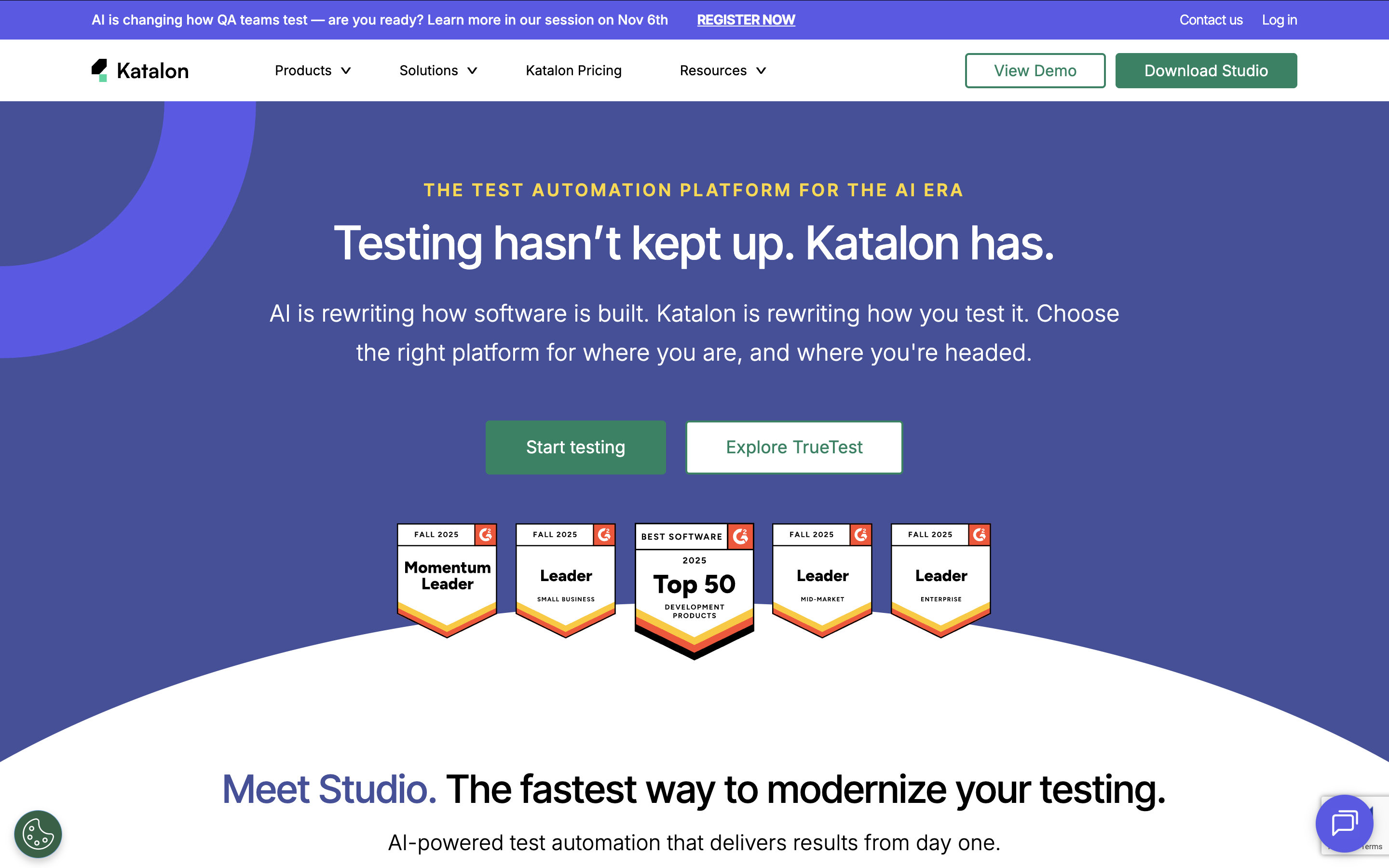
Key features:
- Test authoring modes: For teams who want to get started quickly or don’t have the technical bandwidth to maintain scripts, Katalon provides Record-and-Playback and a rich keyword library. For more advanced users, a Java/Groovy scripting mode is available.
- Test organization: Objects captured during Record-and-Playback are stored in a structured Object Repository for easy reuse. Test cases can be grouped into suites and collections, with support for custom tags.
- Compatibility testing: Supports local and cloud browsers, devices, and operating systems to run API, end-to-end, and regression tests in parallel.
- Easy maintenance: A built-in object repository centralizes UI elements and locators, making updates simple when the application changes.
- Requirements traceability: Native integrations with Jira, qTest, and Xray.
- Test reporting and analytics: Generates detailed reports in popular formats after each execution. Reports can be shared easily and integrate with communication tools for better collaboration.
Katalon includes all essential frameworks for functional testing, including Data-driven Testing (DDT), Behavior-driven Development (BDD), and Keyword-driven Testing. Teams get immediate access to these capabilities without additional setup.
Katalon also introduces built-in AI features to accelerate functional testing. You can generate test scripts from natural language input, or highlight code and use Explain Code to auto-generate clear comments for teams and stakeholders.
Katalon can integrate with JIRA, analyze ticket descriptions, extract testing requirements, and produce complete manual test cases tailored to the scenario.
Visit Katalon Website | Pricing | G2 Reviews
2. LambdaTest

Type: Cloud-based cross-browser testing tool
LambdaTest is a cloud-based platform providing automated testing solutions to help teams scale testing across a wide range of environments. It supports parallel execution, cross-browser testing, and cross-device testing with extensive environment coverage.
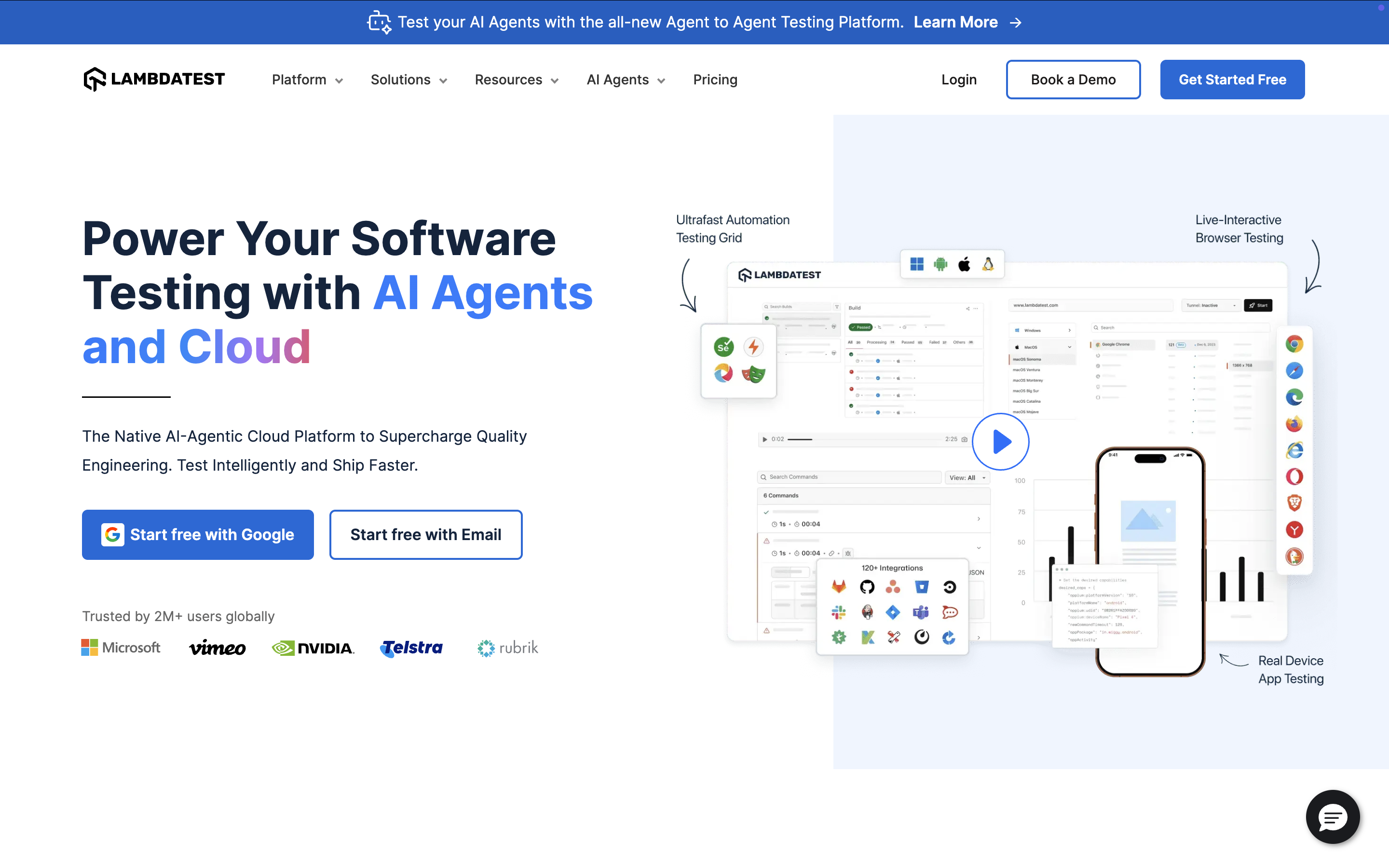
Key features:
- Provides an online Selenium Grid with over 3,000 combinations of browsers, devices, and operating systems.
- Supports geolocation testing across 60+ countries to verify localized content and regional compliance.
- Includes live testing, responsive testing, and AI-powered testing features.
Pricing: Flexible pricing for starters; custom pricing for Enterprise plans
3. Postman

Type: API Testing Tool
Postman is a powerful API development tool that simplifies building, testing, and managing APIs. Originally a Chrome plugin, it has grown into a full standalone application available on Mac, Windows, and Linux.
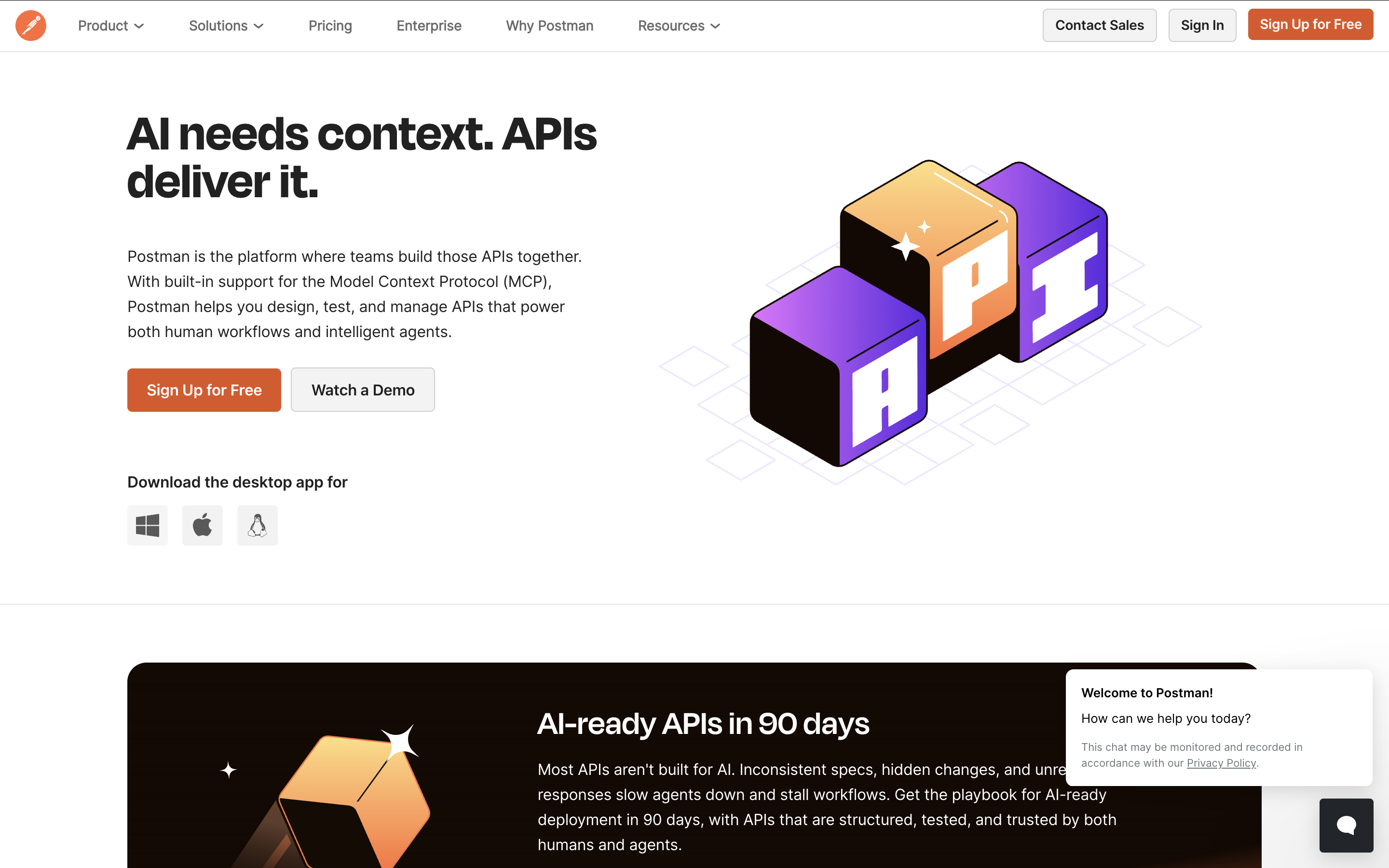
Key features:
- Excellent for manual and automated API testing
- Organize and run test suites efficiently
- Automation with variables, input files, and schedules
- Easy test organization and management
- User-friendly interface supporting multiple data formats
- Supports testing across multiple environments
Pricing: Free – $12/user/month
Visit Postman Website | G2 Reviews
📚 Read More: Top 16 Postman Alternatives For API Testing
4. BrowserStack

BrowserStack is a leading web and mobile testing platform offering over 20,000 real devices and browsers for cross-browser and cross-device testing. QA teams and developers use it for scalable, cloud-based testing.
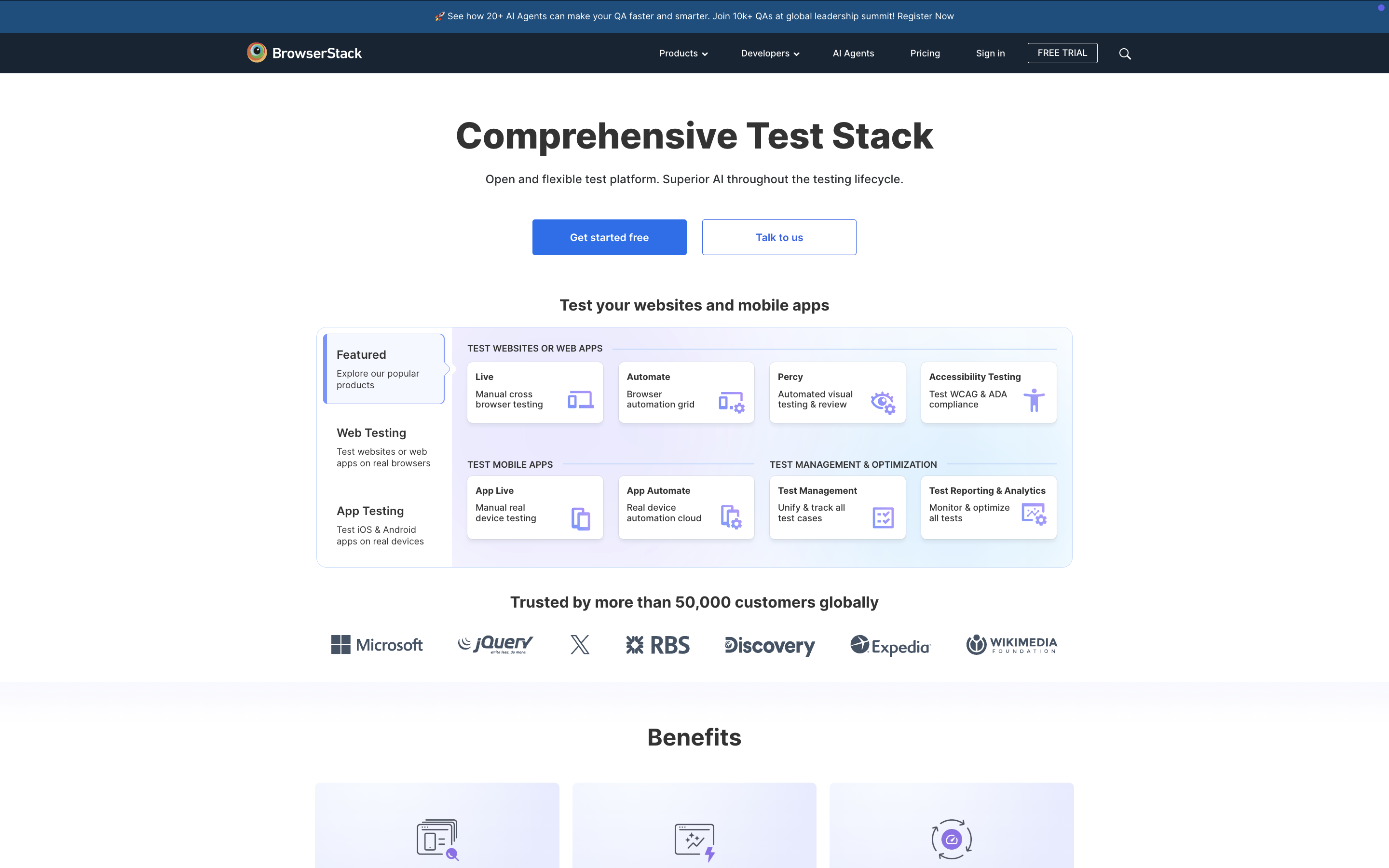
With BrowserStack, you can test and debug on real iOS/Android devices and desktop environments. It supports frameworks such as Selenium, Cypress, Playwright, Puppeteer, and more.
Visit BrowserStack Website | G2 Reviews
Pricing: Plans range from $29/month to $2,999/month depending on testing requirements.
Documentation: BrowserStack Docs
5. Ranorex

Ranorex Studio is a comprehensive automation tool for web, mobile, and desktop applications. Its low-code environment and full IDE make it ideal for both beginners and advanced testers.

Key features:
- Low-code/no-code automation plus a full IDE for deep customization
- Machine-trained object recognition for dynamic UI elements
- Automates desktop, web, and mobile testing
- Supports Windows desktop automation locally or remotely
- Parallel cross-browser testing (Chrome, Firefox, Safari, Edge, etc.)
- Test on real iOS/Android devices, emulators, simulators, or device farms
- Integrates with Jenkins, Jira, TestRail, and major DevOps tools
Visit Ranorex Studio Website | G2 Reviews
Documentation: Ranorex User Guide
6. TestComplete

TestComplete is a versatile automated testing environment designed to support a wide range of application types, including Windows, .NET, WPF, Visual C++, Visual Basic, Delphi, C++Builder, Java, web applications, and mobile. It allows you to build test cases using Keywords that simulate user actions with the Application Under Test, perform Record-and-Playback, and execute those test cases across different environments.
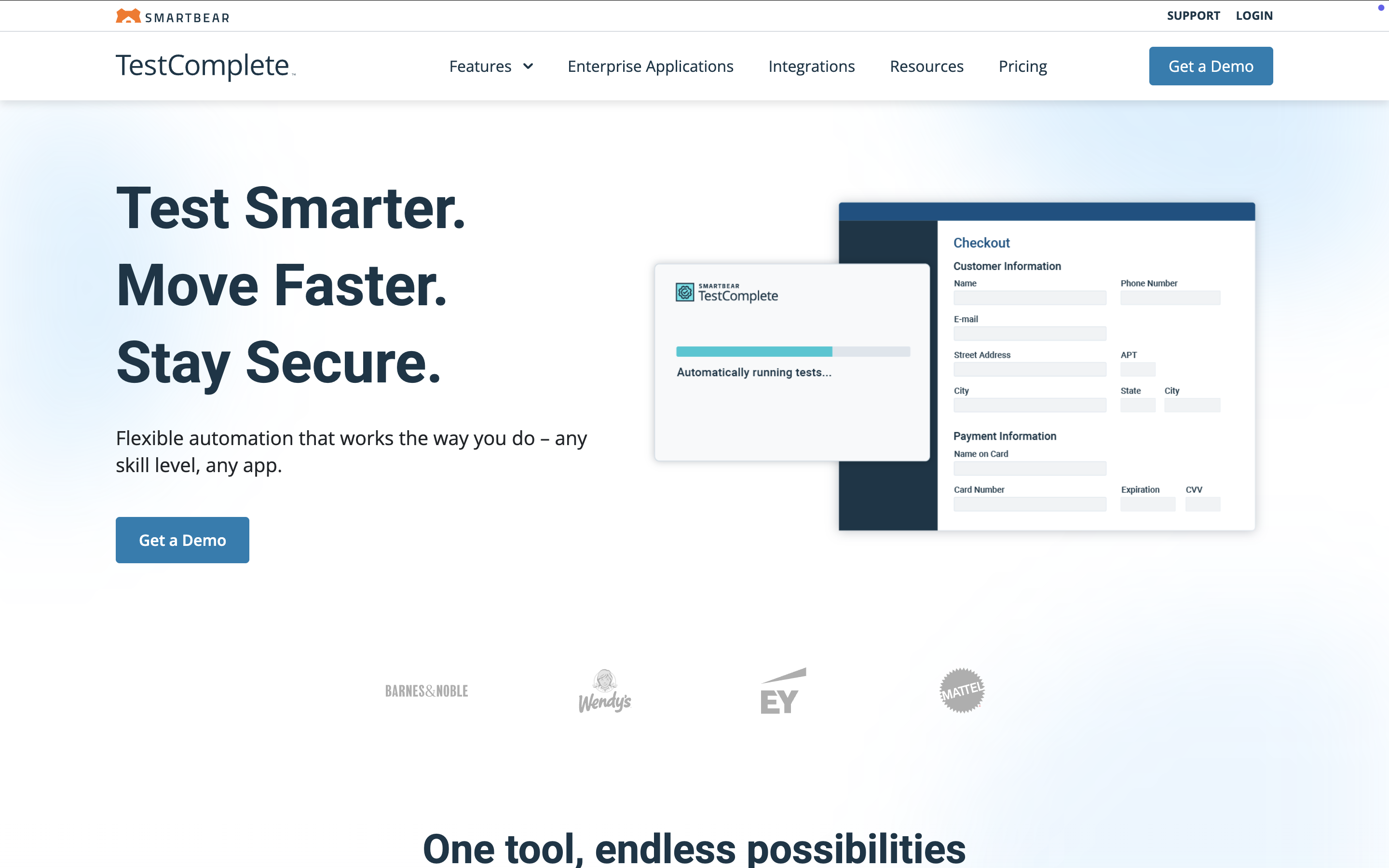
Key features:
- Supports Windows, .NET, WPF, Visual C++, Visual Basic, Delphi, C++Builder, Java, web applications, and mobile.
- Build test cases using Keywords to simulate user actions with modifiable parameters.
- Enables inexperienced users to create reusable test cases across environments.
- Offers scheduling, parallel testing, batch runs, and auto-shutdown for streamlined execution.
- Integrates with CI/CD systems, source control, Selenium, and BitBar Cloud.
Visit TestComplete Website | G2 Reviews
Documentation: SmartBear TestComplete Documentation
7. SoapUI

SoapUI is a leading tool for API testing. This headless functional testing tool supports both REST and SOAP services. Testers can choose between the open-source version or the pro edition, which adds an assertion wizard, form editor, and SQL query builder. SoapUI is part of the ReadyAPI suite from SmartBear.
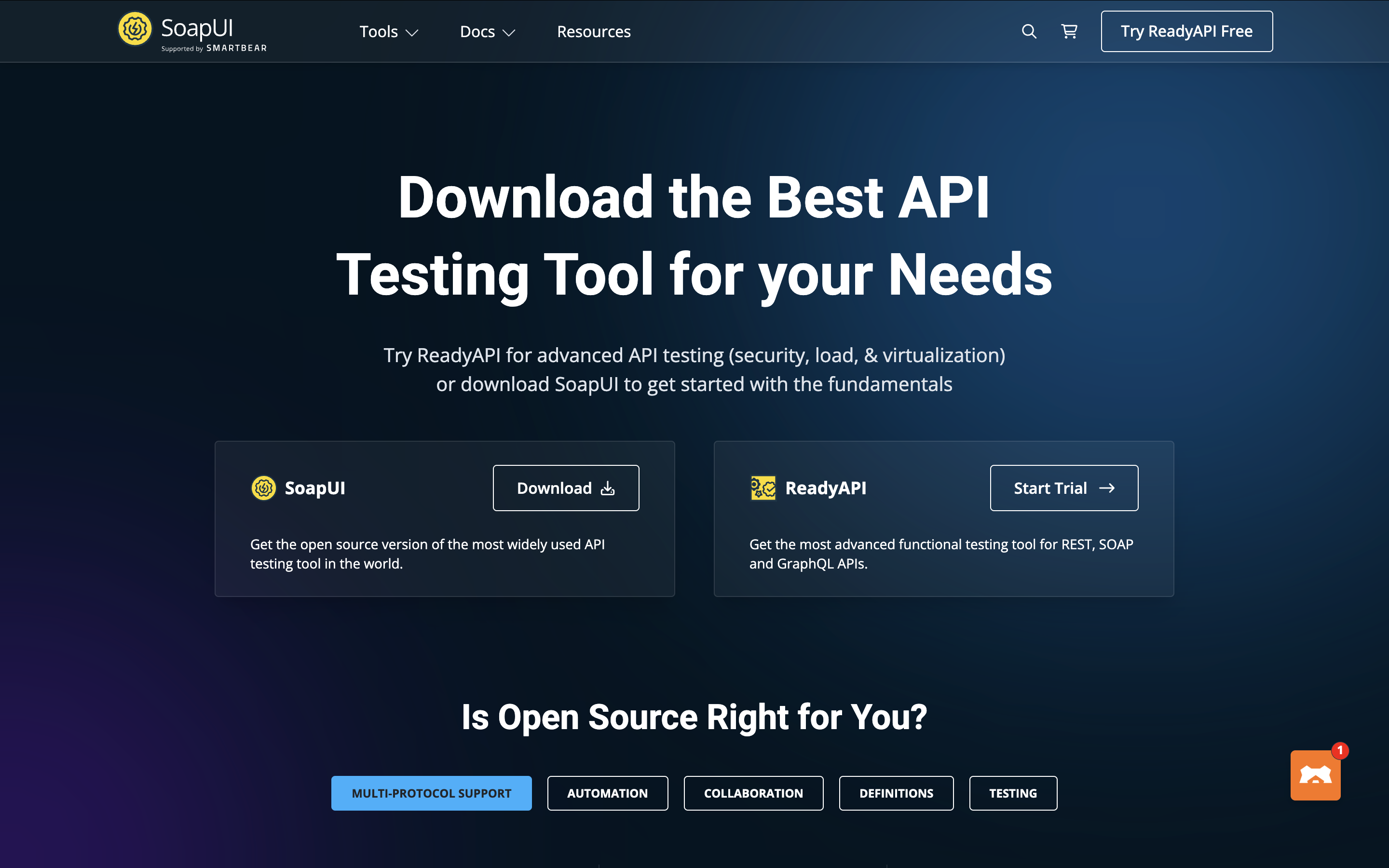
Key features:
- Generate tests via drag-and-drop and point-and-click actions.
- Use data from files and databases for testing scenarios.
- Reuse scripts across multiple tests.
- Mock RESTful services.
- Supports asynchronous testing.
Visit SoapUI Website | G2 Reviews
Documentation: SoapUI Doc
8. JMeter

Type: Performance testing tool
Apache JMeter is a versatile performance testing tool designed to measure and analyze the performance of various services, focusing primarily on web applications.
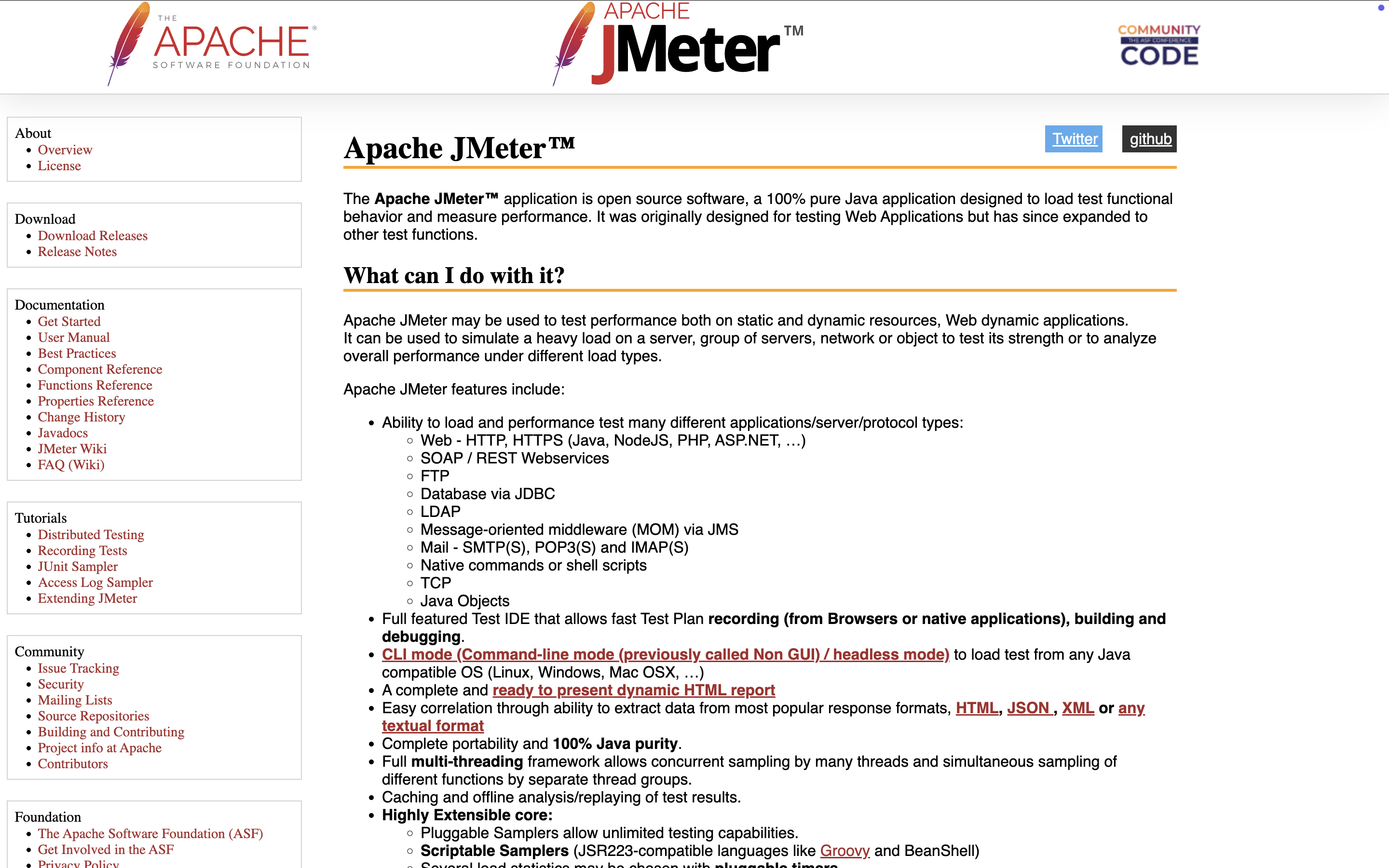
Key features:
- Ideal for static and dynamic resources, including dynamic web apps.
- Simulates heavy server loads under different conditions.
- Supports HTTP, HTTPS, SOAP/REST, FTP, JDBC, LDAP, JMS, mail protocols, shell scripts, TCP, Java objects, and more.
- Provides tools for recording, building, debugging test plans.
- Runs on all Java-compatible operating systems.
- Supports dynamic HTML reporting.
- Extracts and correlates data from HTML, JSON, XML, and text formats.
- Fully portable and 100% Java-based.
- Supports concurrent sampling and separate thread groups.
Visit JMeter Website | G2 Reviews
User Manual: Apache JMeter User Manual
9. LoadRunner

Type: Performance testing tool
LoadRunner, developed by Micro Focus, is a widely used performance testing tool supporting load, stress, and performance testing across numerous protocols and technologies.
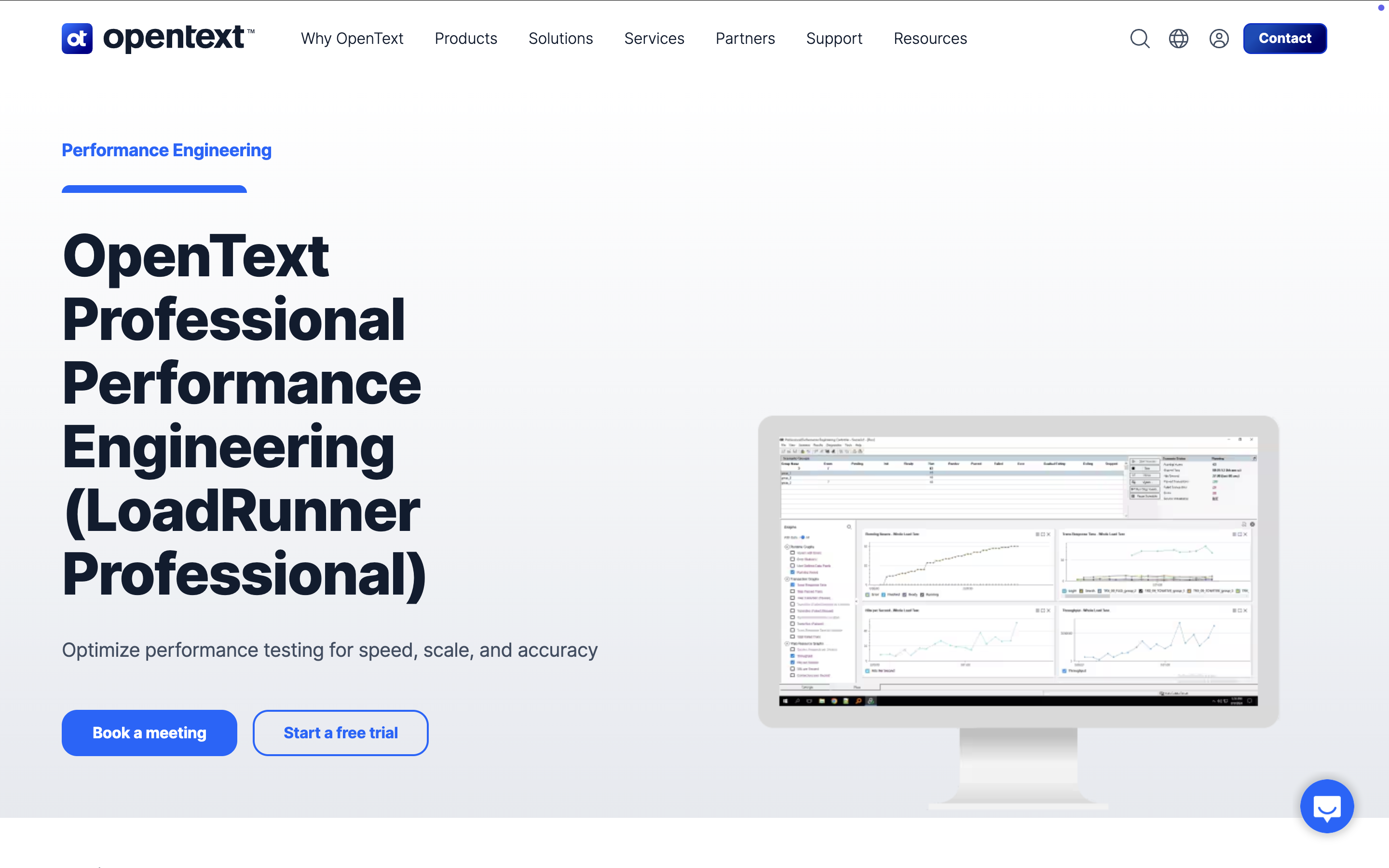
Key Features:
- Supports 50+ technologies including MQTT, HTML5, WebSockets, RDP, Citrix, Java, .NET, Oracle, SAP.
- Patented auto-correlation engine for faster scripting.
- IDE integration for early-stage performance testing.
- Predicts scalability and capacity with realistic load emulation.
- Simulates hundreds or thousands of virtual users.
- Runs high-scale tests using minimal hardware and cloud resources.
- Records, correlates, replays, and enhances scripts easily.
- Integrates with CI/CD pipelines, monitoring tools, SCMs, and open-source automation.
Visit LoadRunner Website | G2 Reviews
Pricing: LoadRunner starts at $0.15/user/hour for Dev VUH, $0.30/user/hour for Web, and $1.50/user/hour for GUI testing.
10. Checkmarx SAST

Checkmarx SAST (Static Application Security Testing) is a leading application security tool designed to identify and mitigate vulnerabilities in source code. It integrates seamlessly into the development lifecycle, enabling developers to detect and resolve security issues early.

Key features:
- Fast and relevant scans identifying high-risk vulnerabilities in critical applications.
- Pinpoints root causes for efficient fixes and batch remediation.
- Uses GenAI with AI Query Builder for optimized SAST and custom query creation.
- Provides AI-driven remediation suggestions and automatic fix generation.
- Scans directly from GitHub, GitLab, Azure, and Bitbucket repositories.
- Supports 35+ languages and 80 frameworks, including legacy platforms.
Visit Checkmarx Website | G2 Reviews
Documentation: Checkmarx Doc
11. TestRail

Type: Test management tool
TestRail is a comprehensive test management platform for planning, tracking, and reporting on software testing activities. It streamlines workflows, improves collaboration, and integrates with a wide range of QA and development tools.
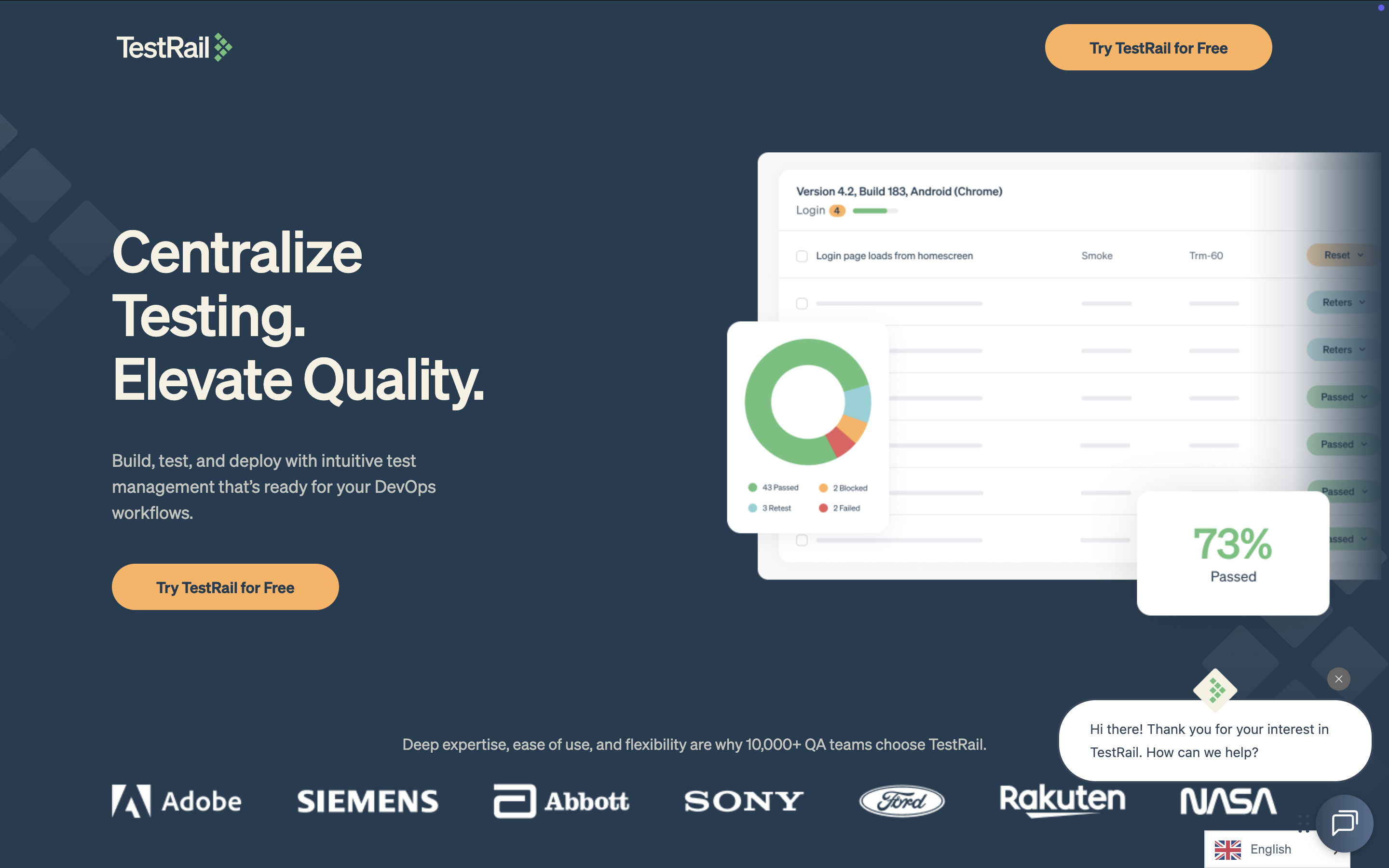
Key features:
- Supports Agile, black box, exploratory, manual, functional, and automated testing.
- Centralized creation and management of test cases.
- Import test cases from Excel or other systems.
- Create and compare multiple test case versions.
- Share test repositories across projects, releases, and sprints.
- Detailed step-by-step execution history.
- Supports run-specific parameters and configurations.
- Multiple reporting formats including execution and case reports.
- Cross-project reporting support.
- Scales to any team size and complexity.
- Integrates with JIRA, Bamboo, HipChat, BugZilla, eggPlant, Cucumber, Jenkins, Selenium, Rally, VersionOne, and 100+ add-ons.
Documentation: TestRail Documentation
12. Mabl

Type: AI-powered testing tool
Mabl is a cloud-based automated testing platform that uses machine learning to deliver resilient, low-maintenance test automation without requiring coding expertise. It supports the full testing lifecycle from creation to execution and monitoring.
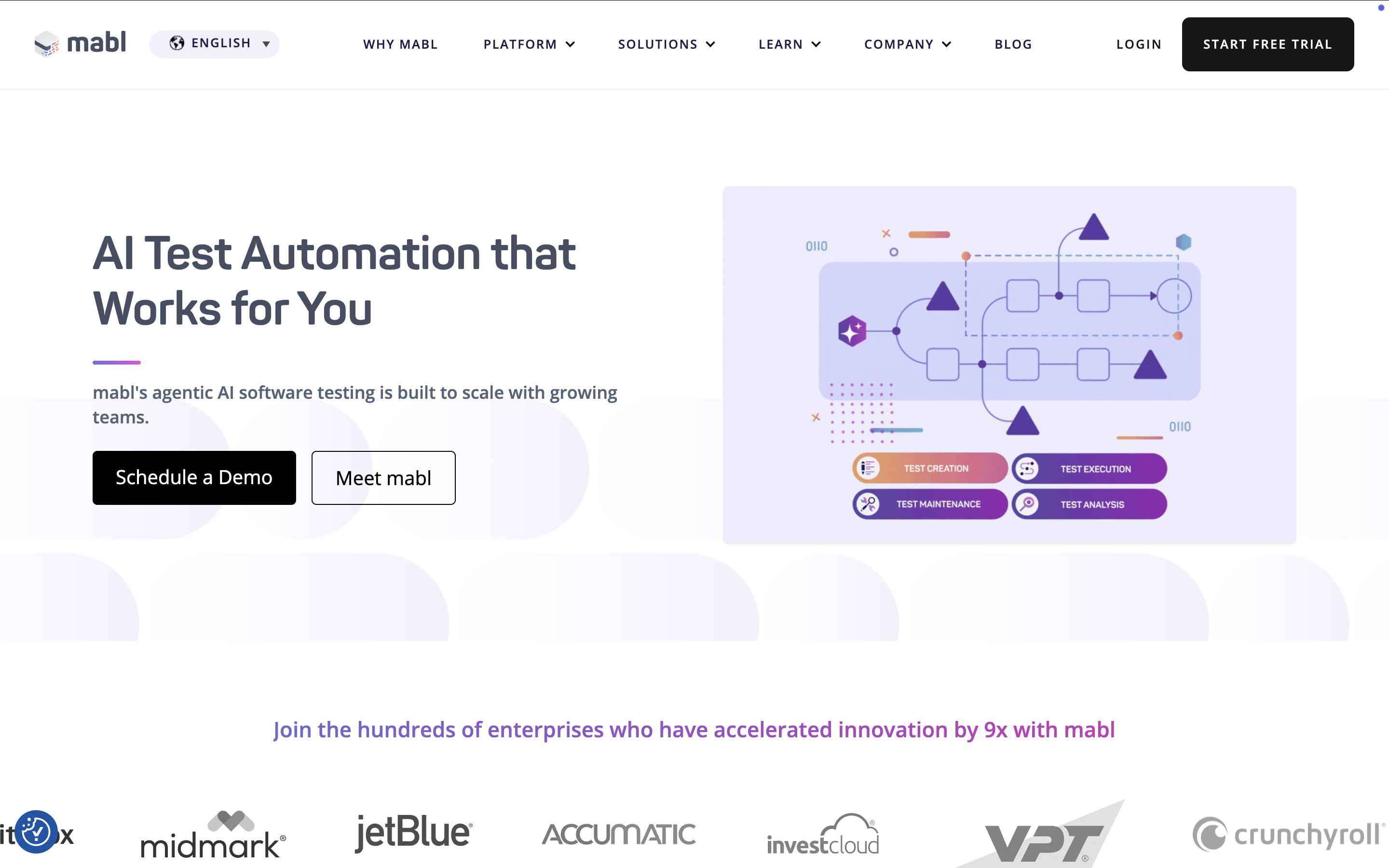
Mabl supports the entire testing lifecycle, making it a powerful solution for modern QA teams.
Key features:
- Lightweight browser plugin for quick test creation.
- Automates browsers similar to Selenium IDE/WebDriver.
- No heavy installation required.
- Auto-healing tests using machine learning to handle UI changes.
- Scriptless automation — no coding required.
- Easy scheduling and execution of tests.
- Rich visuals and anomaly detection dashboards.
- Tracks network spikes and platform performance.
- Email and Slack notification integrations.
- Syncs bugs with JIRA, Bamboo, Jenkins, and other tools.
- Considered a future-ready automation solution.
- Instant demo available from automation specialists.
Visit Mabl Website | G2 Reviews
Documentation: Mabl Help
|
FAQs
What are the main categories of software testing tools “by scope,” and how do they differ?
Open-source frameworks (highly customizable but require building/maintenance), single-point commercial tools (focused on a specific testing need), and full software quality management platforms (all-in-one workspace across the lifecycle).
When should a team choose open-source tools vs. commercial tools/platforms?
Choose open-source when you need maximum customization and can invest in engineering/maintenance; choose commercial tools/platforms when you want faster setup, vendor-managed updates, and smoother scaling across teams and environments.
What types of testing tools are needed across the SDLC (by functionality)?
Manual test management, automated testing, defect/bug tracking, CI/CD tools for continuous execution, and team communication tools for feedback/notifications.
What capabilities should you prioritize if automation is a cornerstone of your release process?
Strong CI/CD integration, reliable reporting/analytics, scalable execution (e.g., parallel runs, broad environment coverage), and a tool/platform that fits complex, interconnected apps without heavy glue-work.
How do the “top tools” in the list map to different testing needs (web/API/performance/security/test management)?
Examples include all-in-one automation (Katalon), cross-browser/device clouds (LambdaTest/BrowserStack), API testing (Postman/SoapUI), performance testing (JMeter/LoadRunner), security testing (Checkmarx SAST), and test management (TestRail), plus AI-driven automation (Mabl).
.jpg)
-2.png)
